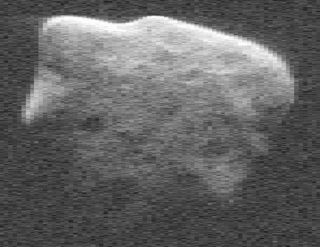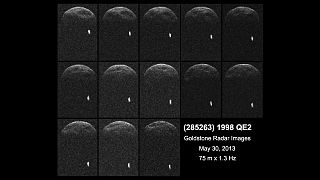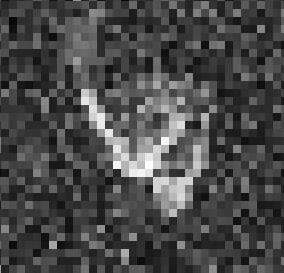Related Research Articles
2063 Bacchus, provisional designation 1977 HB, is a stony asteroid and near-Earth object of the Apollo group, approximately 1 kilometer in diameter. The contact binary was discovered on 24 April 1977, by American astronomer Charles Kowal at the Palomar Observatory in California, United States. It was named after Bacchus from Roman mythology.

4183 Cuno, provisional designation 1959 LM, is an eccentric, rare-type asteroid, classified as near-Earth object and potentially hazardous asteroid of the Apollo group, and measures approximately 4 kilometers in diameter.

(53319) 1999 JM8 is an asteroid, slow rotator and tumbler, classified as a near-Earth object and potentially hazardous asteroid (PHA) of the Apollo group, approximately 7 kilometers (4 miles) in diameter, making it the largest PHA known to exist. It was discovered on 13 May 1999, by astronomers of the Lincoln Near-Earth Asteroid Research at the Lincoln Laboratory's Experimental Test Site near Socorro, New Mexico.

2062 Aten, provisional designation 1976 AA, is a stony sub-kilometer asteroid and namesake of the Aten asteroids, a subgroup of near-Earth objects. The asteroid was named after Aten from Egyptian mythology.
37655 Illapa, provisional designation 1994 PM, is a carbonaceous asteroid, classified as near-Earth object and potentially hazardous asteroid of the Apollo group, approximately 1.5 kilometers in diameter. It was discovered, on 1 August 1994, by American astronomer couple Carolyn and Eugene Shoemaker at the Palomar Observatory in California, United States.
7088 Ishtar, provisional designation 1992 AA, is a synchronous binary asteroid and near-Earth object from the Amor group, approximately 1.3 kilometers in diameter. It was discovered on 1 January 1992, by American astronomer Carolyn Shoemaker at the Palomar Observatory in California. The relatively bright asteroid with an unknown spectral type has a rotation period of 2.7 hours. In December 2005, a 330-meter sized satellite was discovered, orbiting its primary every 20.65 hours.
11066 Sigurd, provisional designation 1992 CC1, is a stony, rare-type asteroid and elongated contact binary, classified as near-Earth object of the Apollo group of asteroids, approximately 2.5 kilometers in diameter.
(5646) 1990 TR is a probable rare-type binary asteroid classified as near-Earth object of the Amor group, approximately 2.3 kilometers in diameter. It was discovered on 11 October 1990, by Japanese astronomers Seiji Ueda and Hiroshi Kaneda at Kushiro Observatory near Kushiro, in eastern Hokkaido, Japan.
(153814) 2001 WN5 is a sub-kilometer asteroid, classified as near-Earth object and potentially hazardous asteroid of the Apollo group.

(7482) 1994 PC1 is a stony asteroid, classified as near-Earth object and potentially hazardous asteroid of the Apollo group, approximately 1.1 kilometers in diameter. It was discovered on 9 August 1994, by astronomer Robert McNaught at the Siding Spring Observatory in Coonabarabran, Australia. With an observation arc of 47 years it has a very well known orbit and was observed by Goldstone radar in January 1997. The 2022 approach has been observed every month since August 2021.

(285263) 1998 QE2, provisional designation 1998 QE2, is a dark asteroid and synchronous binary system, classified as near-Earth object and potentially hazardous asteroid of the Amor group, approximately 3 kilometers in diameter. It was discovered on 19 August 1998, by astronomers of the LINEAR program at Lincoln Laboratory's Experimental Test Site near Socorro, New Mexico, in the United States. Its sub-kilometer minor-planet moon was discovered by radar on 30 May 2013.

(192642) 1999 RD32, provisional designation: 1999 RD32, is an asteroid and suspected contact binary on an eccentric orbit, classified as a large near-Earth object and potentially hazardous asteroid of the Apollo group, approximately 5 kilometers (3 miles) in diameter. It was discovered on 8 September 1999, at a magnitude of 18, by astronomers of the LINEAR program using its 1-meter telescope at the Lincoln Laboratory's Experimental Test Site near Socorro, New Mexico, United States. The asteroid is likely of carbonaceous composition and has a rotation period of 17.08 hours.

2014 HQ124 is a sub-kilometer asteroid, classified as near-Earth object and potentially hazardous asteroid of the Aten group, approximately 400 meters (1,300 feet) in diameter. It passed 3.25 lunar distances (LD) from Earth on 8 June 2014. It was discovered on 23 April 2014 by NEOWISE. It is estimated that an impact event would have had the energy equivalent of 2,000 megatons of TNT and would have created a 5 km (3 mi) impact crater. The news media misleadingly nicknamed it The Beast. 2014 HQ124 previously passed this close to Earth in 1952 and will not again until at least 2307. Radar imaging suggests it may be a contact binary.

2014 RC is a sub-kilometer near-Earth object and Apollo asteroid. The exceptionally fast rotator passed within 0.000267 AU (39,900 km; 24,800 mi) (0.1 lunar distances) of Earth on 7 September 2014. The asteroid is approximately the diameter of the Chelyabinsk meteor, and passed almost as close to Earth as 367943 Duende (2012 DA14) did in 2013.
2015 HM10 is an irregular shaped asteroid and sub-kilometer near-Earth object that passed near the Earth on 7 July 2015, at a distance of 442,000 kilometers or 1.15 lunar distances.

2017 BQ6 is a sub-kilometer asteroid on an eccentric orbit, classified as a near-Earth object and potentially hazardous asteroid of the Apollo group, approximately 150 meters in diameter. It was discovered on 26 January 2017, by the Space Surveillance Telescope at Lincoln Laboratory's ETS (Atom Site) and passed within 6.6 lunar distances of Earth on 7 February 2017 at 6:36 UT.

2014 JO25 is a near-Earth asteroid. It was discovered in May 2014 by astronomers at the Catalina Sky Survey near Tucson, Arizona - a project of NASA's NEO (Near Earth Object) Observations Program in collaboration with the University of Arizona.
(162421) 2000 ET70 is a dark, elongated and oblate asteroid, classified as near-Earth object and potentially hazardous asteroid of the Aten group, approximately 2.2 kilometers in diameter. It was discovered on 8 March 2000, by astronomers of the Lincoln Near-Earth Asteroid Research at the Lincoln Laboratory's Experimental Test Site near Socorro, New Mexico. The body has a notably low albedo, and its shape resembles that of a "clenched fist".

(505657) 2014 SR339, provisional designation 2014 SR339, is a dark and elongated asteroid, classified as near-Earth object and potentially hazardous asteroid of the Apollo group, approximately 970 meters (3,200 feet) in diameter. It was discovered on 30 September 2014, by NASA's Wide-field Infrared Survey Explorer telescope (WISE) in Earth's orbit. Closely observed at Goldstone and Arecibo in February 2018, it has a rotation period of 8.7 hours.
(85182) 1991 AQ, provisional designation 1991 AQ, is a stony asteroid on a highly eccentric orbit, classified as near-Earth object and potentially hazardous asteroid of the Apollo group, approximately 1.1 kilometers in diameter. It was discovered on 14 January 1991, by American astronomer Eleanor Helin at the Palomar Observatory in California. Based on its brightness variation of 0.69 magnitude, this Q-type asteroid is likely elongated. It belongs to the small group of potentially hazardous asteroids larger than one kilometer.
References
- 1 2 "JPL Small-Body Database Browser: (2015 TC25)" (2017-04-25 last obs). Retrieved 11 June 2019.
- 1 2 3 4 5 6 Reddy, Vishnu; Sanchez, Juan A.; Bottke, William F.; Thirouin, Audrey; Rivera-Valentin, Edgard G.; Kelley, Michael S.; Ryan, William; Cloutis, Edward A.; Tegler, Stephen C.; Ryan, Eileen V.; Taylor, Patrick A.; Richardson, James E.; Moskovitz, Nicholas; Le Corre, Lucille (2016). "PHYSICAL CHARACTERIZATION OF ~2 m DIAMETER NEAR-EARTH ASTEROID 2015 TC25: A POSSIBLE BOULDER FROM E-TYPE ASTEROID (44) NYSA". The Astronomical Journal. 152 (6): 162. arXiv: 1612.00113 . Bibcode:2016AJ....152..162R. doi:10.3847/0004-6256/152/6/162. S2CID 58907935.
- 1 2 Stolte, Daniel. "It's a Bird … It's a Plane … It's the Tiniest Asteroid!". UA News. University of Arizona . Retrieved 17 February 2017.